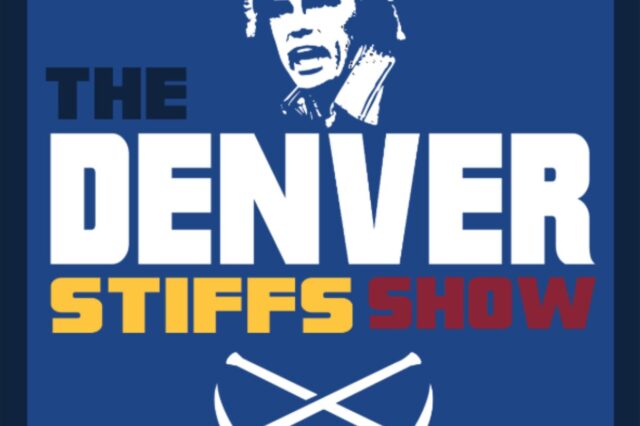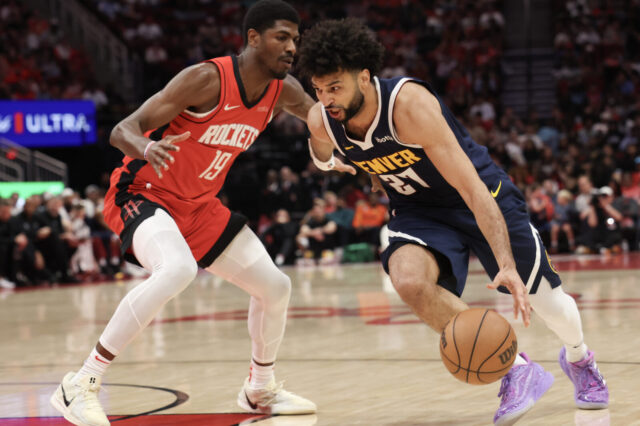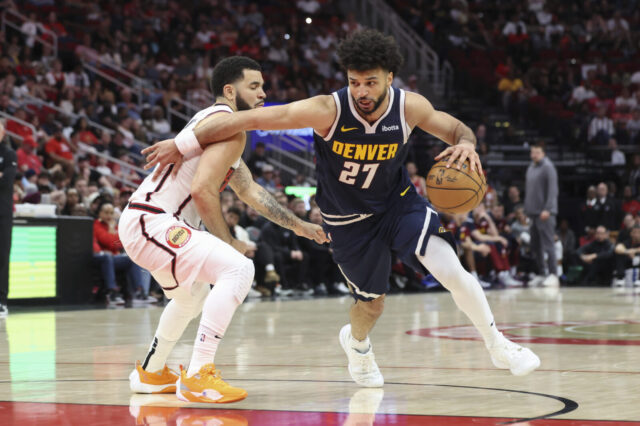Is it hyperbole to call this Denver Nuggets roster the most talented in franchise history?
There are a few candidates. The 1977-78 roster featured David Thompson, Dan Issel, and Bobby Jones, an elite trio that lost in the Western Conference Finals to the NBA champion Seattle SuperSonics. The 1984-85 roster featured an older Issel to mentor Alex English, Fat Lever, and Calvin Natt all the way to another Conference Finals loss, this time to the NBA champion Los Angeles Lakers. The 2008-09 roster featured a prime Carmelo Anthony, an older Chauncey Billups, and a smattering of quality role players.
This year just feels a little different. A little more potent. A group that Nikola Jokić and Jamal Murray led to the Conference Finals just a few months ago is working in one of the most talented young scorers in the NBA today. Michael Porter Jr. has the potential to immediately make an impact in his second full season. Last year in the playoffs, Porter averaged just 11.4 points per game as primarily a wing shooter off the bench. His role will increase this year; it’s just a matter of how much and how soon.
That’s where Michael Malone comes in. Having overseen the development of this franchise for the past five seasons, Malone enters the sixth with the most complex roster to date. Seven new players, six players classified as rookies, three holdovers with major question marks, two superstars, and the most polarizing scoring prospect in the NBA in years. All of them together form the 2020-21 Nuggets roster, and Malone has to manage it to the best of his ability.
This content is no longer available.
Building a rotation is par for the course in most seasons, but this year draws several new challenges. To begin, 12 players are believed to be good enough right now to justify immediate playing time. Excluding holdover Vlatko Čančar, first round picks Zeke Nnaji and R.J. Hampton, and two-way contract players Markus Howard and Greg Whittington, the rest of the roster could realistically earn significant minutes. Most coaches don’t play 12 players though, Malone included. If Malone decides to go with a 10-man rotation, it’s likely that two of Facundo Campazzo, P.J. Dozier, Bol Bol, and Isaiah Hartenstein will be out of the rotation. If Will Barton isn’t ready to go immediately, then only one of the above group need be sidelined.
There are two major questions Malone will answer before the rest of the rotation can fall into place. They are:
- Is it time to slot Michael Porter Jr. into the starting unit for good?
- Is it best to maximize talent, fit, or some combination with the starting group?
The first question is simple but pivotal: if Porter moves into the starting unit, it could potentially kickstart a new version of Denver Nuggets basketball. Three elite scorers in the starting unit that do so in drastically different ways: Jokić with creativity and soft touch, Murray with a technician’s skill set of moves, and Porter with limitless range from all over the floor. If Porter doesn’t move into the starting lineup, Gary Harris and Will Barton are all but guaranteed to retain their starting spots on the wing while Porter operates as a sixth man off the bench.
The second question is more complex and requires an answer to the first question. For the sake of the argument, let’s assume that Porter is starting on opening night. A unit featuring Murray, Porter, and Jokić is so new and likely needs a full season to evaluate what it needs to be the best it can be. Right now though, it’s safe to say that versatile defense and off-ball shooting would go a long way. There are several players that meet that criteria to varying degrees though, and the decisions made in the starting lineup also impact the bench unit significantly.
Let’s talk about different rotation variations:
Rotation #1: Team defense around Porter
This content is no longer available.
Strengths
- Strong team defenders insulating Murray, Porter, and Jokić
- Barton maintains a significant role as a sixth man
- Campazzo, Morris, and Barton should lift bench units
Weaknesses
- Limited ball handling in starting unit
- Small bench backcourt
Overview
This rotation is probably the easiest to craft with the most defined roles on the team. Porter is the starter, but Barton is the versatile sixth man who spends nearly equivalent time with the starters and the second unit. Harris and Millsap have their minutes limited, and they come almost entirely with the Murray-Porter-Jokić trio to insulate the group defensively. This is the rotation that seems the most likely, retaining two incumbent starters for their defensive utility while Porter replaces Barton as the offensive piece.
Rotation #2: Mixing things up
This content is no longer available.
Strengths
- Strongest mix of talent and fit with Barton representing the former and Green the latter
- Harris and Millsap improve the team defense on the bench unit
- Campazzo and Morris have minutes staggered on bench units
Weaknesses
- No elite defenders in starting unit
- A brief ultra-small bench backcourt trio of Campazzo, Morris, and Harris
- Lack of potent scoring off the bench
Overview
This rotation feels like an adherence to both talent and fit, grouping Barton with Murray, Porter, and Jokić as the likely four best players on the team right now. It could be a mistake to break up that quartet before it’s had an opportunity to grow together; however, no player in that group is a significant defender, and JaMychal Green, though solid, isn’t spectacular on that end. In addition, starting Barton and Porter together means some Harris minutes at small forward in all likelihood.
Rotation #3: Put the five best players on the floor
This content is no longer available.
Strengths
- By far the best starting lineup offensively; Porter at power forward is lethal
- Limits minutes of JaMychal Green and Paul Millsap early
- More size off bench by inserting Bol Bol (or PJ Dozier even) at small forward
Weaknesses
- Lots of compounding defensive issues with the starters
- No true roll man in pick and roll off the bench
Overview
The dynamic of starting the five best players on the roster isn’t a new one. The Houston Rockets decided to go with Micro Ball in part because their five best players were small and they could upgrade from Clint Capela to Robert Covington at the deadline. In Denver, the process would be similar with none of Harris, Barton, or Porter going to the bench and instead all starting and finishing games together. Denver’s defense would weaken, but if the goal is to maximize point differential no matter what, then putting the five best players on the court is a good place to start.
Rotation #4: What if Barton isn’t ready?
This content is no longer available.
Strengths
- Strong team defenders insulating Murray, Porter, and Jokić
- Murray and Porter could stagger even more to score with bench units
- Finding some Bol Bol minutes
Weaknesses
- No Barton, meaning Nuggets are searching for competent backup small forward minutes
- Limited ball handling in starting unit
Overview
Here’s an example of a rotation concept that doesn’t feature Barton. Bol takes some backup small forward minutes while Harris soaks up some small ball minutes temporarily. This would be a good opportunity to insert P.J. Dozier in the lineup, who hasn’t shown up in any of the rotation concepts but can reprise what Barton does with less shooting and more defense. This isn’t an ideal situation by any means, but the Nuggets could survive for a few weeks this way.
Rotation #5: Condensing to a 9-man group
This content is no longer available.
Strengths
- Significant minutes and role for Porter with and without Murray and Jokić
- Finding quality minutes for Bol Bol (and with Porter on the floor)
- Barton reprises role as sixth man with heavy minutes
Weaknesses
- Heavier minutes for almost everyone, perhaps a bad idea in a condensed season
- No true roll man off the bench
Overview
This is likely the best possible rotation, highlighted by having nine players who are either true one-position players or players who can slide between multiple positions. Bol Bol establishes himself in this rotation as a guy who can play small forward or power forward (though he’s playing entire PF here). Porter stands out as having a major minutes bump while also being the starter who stays on the floor with the second unit while Murray and Jokić have their minutes tied together. Murray and Porter could certainly switch places, but this configuration allows Porter and Bol to play on the floor together, flanked by Morris, Barton, and Millsap.
Which rotation appears best mostly depends on what Michael Malone wants to accomplish with this group. The first and second options are mirror images of each other and depend mostly on whether Malone feels that Harris or Barton is the best option at shooting guard and whether Millsap or Green is the best option at power forward. The third option maximizes the offense by putting the five best players on the floor. The fourth option gives Barton time to rehab and recover even more. The fifth option nullifies almost everything by giving everyone in the top nine minutes and hoping talent wins out overall.
Whatever Michael Malone decides to do, the Nuggets have several difficult decisions to make. The first rotation is unlikely to be the last, and it’s possible that the roster looks different after the trade deadline anyway. Could Porter, Bol, Dozier, or someone outside the top 12 make an even larger push for minutes though?
We will see.
This content is no longer available.


